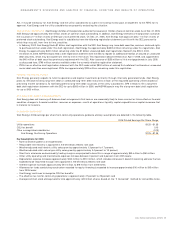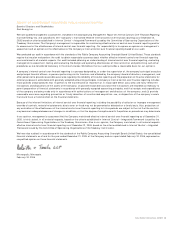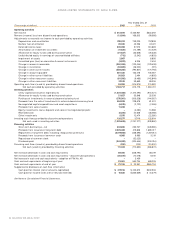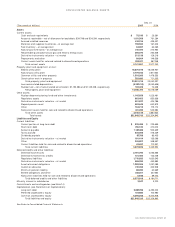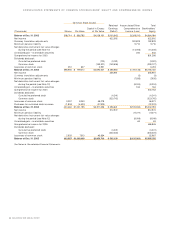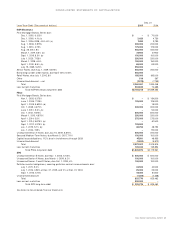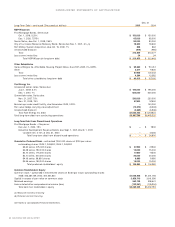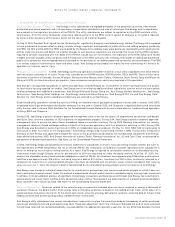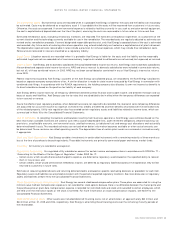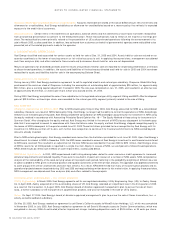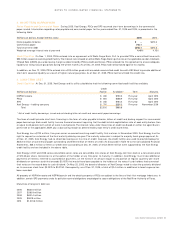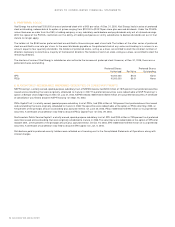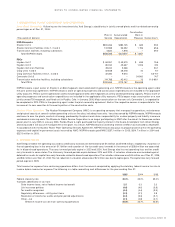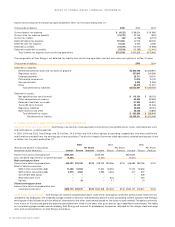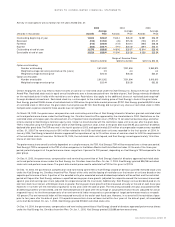Xcel Energy 2005 Annual Report Download - page 49
Download and view the complete annual report
Please find page 49 of the 2005 Xcel Energy annual report below. You can navigate through the pages in the report by either clicking on the pages listed below, or by using the keyword search tool below to find specific information within the annual report.1. SUMMARY OF SIGNIFICANT ACCOUNTING POLICIES
Business and System of Accounts
Xcel Energy’s utility subsidiaries are engaged principally in the generation, purchase, transmission,
distribution and sale of electricity and in the purchase, transportation, distribution and sale of natural gas. Xcel Energy and its subsidiaries
were subject to the regulatory provisions of the PUHCA. The utility subsidiaries are subject to regulation by the FERC and state utility
commissions. All of the utility companies’ accounting records conform to the FERC uniform system of accounts or to systems required
by various state regulatory commissions, which are the same in all material respects.
On Aug. 8, 2005, President Bush signed into law the Energy Act, significantly changing many federal energy statutes. The Energy Act is expected
to have a substantial long-term effect on energy markets, energy investment, and regulation of public utilities and holding company systems by
the FERC, the SEC and the DOE. The FERC was directed by the Energy Act to address many areas previously regulated by other governmental
entities under the statutes and determine whether changes to such previous regulations are warranted. The issues that the FERC has been
required to consider associated with the repeal of the PUHCA include, but are not limited to, the expansion of the FERC authority to review
mergers and sales of public utility companies and the expansion of the FERC authority over the books and records of holding companies and
public utility companies, and the appropriate cost standard for the provision of non-power goods and services by service companies. The FERC
is in various stages of rulemaking on these and other issues. Xcel Energy cannot predict the impact the new rulemakings will have on its
operations or financial results, if any.
Principles of Consolidation
In 2005, Xcel Energy continuing operations included the activity of four utility subsidiaries that serve electric
and natural gas customers in 10 states. These utility subsidiaries are NSP-Minnesota, NSP-Wisconsin, PSCo and SPS. These utilities serve
customers in portions of Colorado, Kansas, Michigan, Minnesota, New Mexico, North Dakota, Oklahoma, South Dakota, Texas and Wisconsin.
Along with WGI, an interstate natural gas pipeline, these companies comprise our continuing regulated utility operations.
Xcel Energy’s nonregulated subsidiaries in continuing operations include Eloigne Co. (investments in rental housing projects that qualify
for low-income housing reported tax credits). Xcel Energy owns the following additional direct subsidiaries, some of which are intermediate
holding companies with additional subsidiaries: Xcel Energy Wholesale Energy Group Inc., Xcel Energy Markets Holdings Inc., Xcel Energy
Ventures Inc., Xcel Energy Retail Holdings Inc., Xcel Energy Communications Group Inc., Xcel Energy WYCO Inc. and Xcel Energy O&M
Services Inc. Xcel Energy and its subsidiaries collectively are referred to as Xcel Energy.
Discontinued utility operations include the activity of Viking, an interstate natural gas pipeline company that was sold in January 2003; BMG,
a regulated natural gas and propane distribution company that was sold in October 2003; and Cheyenne, a regulated electric and natural gas
utility that was sold in January 2005. See Note 2 to the Consolidated Financial Statements for more information on the discontinued operations
of Viking, BMG and Cheyenne.
During 2005, Xcel Energy’s board of directors approved management’s plan to pursue the sale of UE (engineering, construction and design)
and Quixx Corp. (a former subsidiary of UE that partners in cogeneration projects). During 2004, Xcel Energy’s board of directors approved
management’s plan to pursue the sale of Seren (broadband telecommunications services). During 2003, Planergy International, Inc. (energy
management solutions) closed and began selling a majority of its business operations, with final dissolution occurring in 2004. During 2003,
Xcel Energy also divested its ownership interest in NRG, an independent power producer. On May 14, 2003, NRG filed for bankruptcy to
restructure its debt. As a result of the reorganization, Xcel Energy relinquished its ownership interest in NRG. During 2003, the board of
directors of Xcel Energy also approved management’s plan to exit businesses conducted by the nonregulated subsidiaries Xcel Energy
International and e prime. NRG, Xcel Energy International, e prime, Seren, Planergy International, Inc., UE and Quixx Corp. are presented as
components of discontinued operations. See Note 2 to the Consolidated Financial Statements.
In 2004, Xcel Energy began consolidating the financial statements of subsidiaries in which it has a controlling financial interest, pursuant to
the requirements of FASB Interpretation No. 46, as revised (FIN No. 46). Historically, consolidation has been required only for subsidiaries in
which an enterprise has a majority voting interest. As a result, Xcel Energy is required to consolidate a portion of its affordable housing
investments made through Eloigne, which for periods prior to 2004 are accounted for under the equity method. As of Dec. 31, 2005, the
assets of the affordable housing investments consolidated as a result of FIN No. 46, as revised, were approximately $136 million and long-term
liabilities were approximately $75 million, including long-term debt of $72 million. Investments of $51 million, previously reflected as a
component of investments in unconsolidated affiliates, have been consolidated with the entities’ assets initially recorded at their carrying
amounts as of Jan. 1, 2004. The long-term debt is collateralized by the affordable housing projects and is nonrecourse to Xcel Energy.
Xcel Energy uses the equity method of accounting for its investments in partnerships, joint ventures and certain projects for which it does not
have a controlling financial interest. Under this method, a proportionate share of pretax income is recorded as equity earnings from investments
in affiliates. In the consolidation process, all significant intercompany transactions and balances are eliminated. Xcel Energy has investments in
several plants and transmission facilities jointly owned with other utilities. These projects are accounted for on a proportionate consolidation
basis, consistent with industry practice. See Note 7 to the Consolidated Financial Statements.
Revenue Recognition
Revenues related to the sale of energy are generally recorded when service is rendered or energy is delivered to
customers. However, the determination of the energy sales to individual customers is based on the reading of their meter, which occurs on a
systematic basis throughout the month. At the end of each month, amounts of energy delivered to customers since the date of the last meter
reading are estimated and the corresponding unbilled revenue is estimated.
Xcel Energy’s utility subsidiaries have various rate-adjustment mechanisms in place that currently provide for the recovery of certain purchased
natural gas and electric fuel and purchased energy costs. These cost-adjustment tariffs may increase or decrease the level of costs recovered
through base rates and are revised periodically, as prescribed by the appropriate regulatory agencies, for any difference between the total
XCEL ENERGY 2005 ANNUAL REPORT 47
NOTES TO CONSOLIDATED FINANCIAL STATEMENTS


